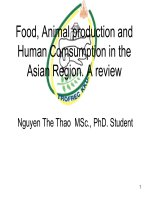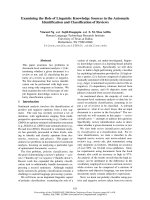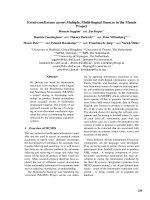some renewable energy sources in the ASEAN region
Bạn đang xem bản rút gọn của tài liệu. Xem và tải ngay bản đầy đủ của tài liệu tại đây (46.3 KB, 9 trang )
1
SOME RENEWABLE ENERGY SOURCES IN THE ASEAN REGION & THEIR
ENVIRONMENTAL IMPACTS
Er Dr Adhityan Appan
Technical Adviser
LBW Consultants*; RJ Crocker Consultants
*Blk 265, Serangoon Central Drive #02-273
Singapore 550265
Tel: +65 98003024
Fax: +65 63535248
Email:
1.0 INTRODUCTION
The use of fossil fuels indiscriminately and the damage that has been done to the
environment is leaving mankind with no option but to resort to other sources of energy.
Ideally these sources should be relatively easily renewable and readily available.
However, special attention should be paid to ensure that they are not harmful to the
environment and should in no way be cause for environmental damage in the future. The
main objectives of this paper are:
• to identify three main renewable energy sources that have potential and are
being developed in the ASEAN region
• to study recent installations and operations of such systems and their potential
for creating environmental problems and
• to draw conclusions on their current use and make recommendations to
minimise environmental damage in the future.
2.0 MAJOR RENEWABLE RESOURCES IN THE ASEAN REGION
The Asean region has a typically tropical climate which is hot and humid throughout the
year. The range of temperatures is 15 to 40
o
C and the average temperature is 29
o
C (1).
Since rainfall is largely seasonal, there are long dry periods in between. Such conditions
are conducive for the effective harnessing and use of solar energy. Traditionally, in this
region, solar energy has been predominantly used for heating water and drying purposes.
However, penetration of solar photovoltaic (PV) systems has been growing across the
region over the last ten years, where it is used mainly for electrifying rural and remote
homes and villages.
Most of Cambodia, the Philippines, Vietnam and some parts of Thailand have long
coastal areas and also mountains from 2000 to 3000m high. These locations have been
2
identified as most suitable for the harnessing of wind energy, another renewable energy
source (Cunanan, 2002).
Asean countries lie mainly in the Southeast Asian region and span the equator. Since they
are all under the influence of the Asiatic monsoons, they have abundant seasonal annual
rainfalls in the range of 1000 to 5000 mm (2). Hence, in all these countries, there are
rivers with perennial runoff. This has led to the construction and operation of hydro-
electric projects varying in size from small to large to capacities (Bucta 2007,
Battachary & Kumar2005).
3. ENVIRONMENTAL FACTORS AFFECTING SOME RENEWABLE ENERGY
SOURCES
3.1 SOLAR ENERGY
Silicon cells are still the most commonly used PV cells. Crystalline silicon cells are
expected to continue as the dominant type for the next 5 to 10 years (Goetzberger, et al.,
2003).
The expected future trend in the PV industry is to produce more thin-film cells, which
have potential for higher energy efficiency and hence lower cost per unit of electricity
generated.
3.1.1 Factors influencing the Environment
a. Energy: Energy is required to manufacture and install solar components and any fossil
fuels used for this purpose will generate emissions. Thus, an important question is how
much fossil energy input is required for solar systems compared to the fossil energy
consumed by comparable conventional energy systems.
Unlike fossil fuel-based technologies, solar power does not lead to any harmful emissions
during operation, but the production of the panels leads to some amount of air pollution.
b. Life Cycle Emissions: In the case of solar panels, the life-cycle greenhouse gas
emissions are currently in the range of 35-45 g/kWh (Alsema et al, 2006) and this could
decrease to 15 g/kWh in the future (Alsema et al, 2006a).
The values for other sources
are:
For gas-fired Power Plant 400 g/kWh
For Coal-powered Power plant 915 g/kWh
For Nuclear Power 6-25 g/kWh
3
For Wind Turbines 11 g/kWh
c. Health and Safety
: Materials used in some solar systems can create health and safety
hazards for workers and anyone else coming into contact with them. In particular, the
manufacturing of some photovoltaic cells requires hazardous materials such as Arsenic
and Cadmium.
With respect to silicon-based cells, the primary concerns for human health are from the
use of toxic gases and solvents during manufacturing. Arsine and phosphine gases are
used in the production of silicon-based cells. The potential impacts are primarily at the
manufacturing facilities for workers and for nearby residents, particularly if accidents
occur. The completed, installed silicon-based cells pose minimal risks to human health
or the environment.
Even relatively inert silicon, a major material used in solar cells, can be hazardous to
workers if it is breathed in as dust. Workers involved in manufacturing photovoltaic
modules and components must consequently be protected from exposure to these
materials.
Cadmium is potentially of concern with the thin-film technologies. In its metallic form it
is toxic and has the tendency to accumulate in ecological food chains. The amount of
cadmium used in thin-film PV modules is relatively small in the range of 0.55-14 g/m²
(Zweikbel et al, 1998) and with proper emission control techniques in place the cadmium
emissions from module production can be almost zero
Use of cadmium can generate cadmium-containing wastewater, and possibly cadmium
fumes and dusts.
At completed installations of photovoltaic systems for power generation, the potential for
chemical releases appears to be small since the chemicals are present in the sealed PV
modules. Releases are likely to occur only due to fires or other unusual accidents.
Cadmium could be a potential concern in this setting with thin-film technologies, as
would arsenic and zinc to a lesser extent.
Leaching of metals from the installed modules is not likely to be of concern (Steinberger,
1998). Leaching from small cells used in electronic devices is also unlikely to be a
concern, given the small amounts of chemicals present and the sealed nature of the
devices.
d. Disposal
: Little information on disposal of used PV modules is available. Both
cadmium and copper are a potential concern to biota due to their acute toxicity,
depending on the conditions in a receiving waterbody and the specific type of biota.
3.2 WIND ENERGY
4
The earliest existence of windmills can be traced to the first century AD. (Drachmann,
1961). Windmills were used in Europe to grind flour in 12
th
century and subsequent
Dutch windmills still exist (Lohrmann, 1995). The modern wind turbine was developed
in the 1980s and designs are still under development.
3.2.1 Factors influencing the Environment
a. Water & Air Pollution: The operation of wind turbines does not involve activities
resulting in or being cause for any form of water or air pollution. Besides, these turbines
are also not involved in the production of any special toxic or hazardous substances other
than those commonly found in identical large machines.
b. Ice: This is an issue which caused concern mainly in Europe where there is the
potential danger of ice being adhered to wind turbine blades. Due to the speed of rotation,
vibration in the system and state of ice formation, ice can get detached and blown off the
turbine blades. Detailed surveys and studies (Hassan G et al, 1998) have established that
there has been no reported injury in spite of the installation of more than 600 mega Watts
of wind energy world wide. It was concluded that the risk of anything or anyone being
hit by ice from a wind turbine has a probability of a person being hit by a lightning strike
in the UK.
c. Noise: In wind turbines, the noise emitted can be due to the moving mechanical parts
or due to revolution of blades. Modern wind turbines are very quiet machines in relation
to their power and through their manufacturers’ continuing improvements keep getting
quieter. It was observed that (Binopoulos, E & P. Haviarapoulos, 2005) the level of
audible noise from a wind turbine, built to modern specifications, at a distance of 200
metres, is lower than the background noise level of a small town in the countryside and
so is not considered as a nuisance. In addition, at the wind speeds in which wind turbines
operate, the natural noise (from wind in trees and bushes) covers any noise emanating
from them. Hence it can be safely concluded that wind farms
do not cause an increase in the
existing noise level outside their boundaries and even less in residential areas.
d. Early problems associated with bird deaths: The Altamont Pass Wind Farm is one of
the earliest in California, USA installed after the 1970s energy crisis and in response to
favorable tax policies for investors. It is composed of over 4900 relatively small wind
turbines of various types and is still the largest concentration of wind turbines in the
world, with a capacity of 576 megaWatts (Lowitz, 2008). Bird deaths from electrocution
or collisions with spinning rotors emerged as a problem during a three-year period. To
appraise the magnitude of bird deaths dozens of studies spanning nearly two decades
were undertaken and it is now known (Sagrillo, 2003) that the Altamont Pass situation is
an unusual case. The high raptor mortality there was the result of a convergence of
factors, some of which were due to the bad siting in the local ecosystem while others
were due to the wind turbine and tower technology used at the time. The NWCC Reports
(2003) finally established that commercial wind turbines cause the direct deaths of only
0.01% to 0.02% of all of the birds killed by collisions with man-made structures and
activities in the U.S
5
e. Visibility & effect on Landscape: Visual disturbance is largely subjective and it is
difficult to set standards which will be accepted by everyone. Particularly near populated
areas, wind projects often run into stiff opposition from people who regard them as
unsightly and noisy, or who fear their presence may reduce property values.
f. Effect of Wind Turbines on Farm stock: There is no indication that wind farms have a
negative impact on farming or livestock. Wind turbines are normally spaced a certain
distance apart and the land in between should be regarded as occupied. Hence, it is clear
that farming can continue after the wind farm has been built. The usual sites for wind
farms are in mountainous areas with low vegetation. In these areas, the land is used
mainly as pasture for sheep and goats, which can continue unhindered after the wind farm
has been built.(ref : Greece paper) Besides this, the leasing of land for wind turbines, can
bring substantial benefits to landowners in the form of increased income and land values.
In other settings, however, wind power development can create serious land-use conflicts.
In forested areas it may mean clearing trees and cutting roads, a prospect that is sure to
generate controversy, except possibly in areas where heavy logging has already occurred.
3.3 HYDRO POWER
The use of hydro power in the form of hydro-electric schemes has gained prominence
since the early twentieth century and such schemes have continued to become larger. The
USA alone currently has over 2,000 hydroelectric power plants which supply 49% of its
renewable electricity. (3).
3.3.1 Factors influencing the Environment
a. Emissions: Hydropower is an energy source that makes it possible to produce
electricity without using fossil fuels, and is subsequently not part of the emissions (like
Carbon dioxide and other gases) caused by electricity production in coal, oil, or gas fired
power plants.
b. Encroachment on Nature
: The environmental consequences of the construction of a
dam to harness hydropower are bound to have an impact on nature due to encroachment.
Hence, modern hydropower projects normally take environmental concerns into
consideration thus making the change in river regulation as gentle as possible on nature.
Some of the salient factors are:
(i) Changed water flow
: Hydropower projects will affect the water flow in river
systems. But it is still possible to have a healthy fish stock in a regulated river
system. In fact, many of Norway’s best fishing rivers are regulated.
(ii) Changes in Water Level: Changes to the water level throughout the year can
lead to scouring of fine substances and nourishment and cause erosion along the
shoreline.









